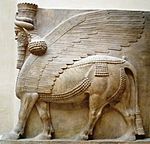Ikunum
- Ikunum
-
Ikunum, 34e roi d'Assyrie (vers 1850 av. J-C.), appartenait à la période paléo-assyrienne.
Fils et successeur de Erishum Ier. On ne connaît pas la durée de son règne car la tablette le répertoriant dans la Chronique des Rois assyriens est brisée. Il maintint les relations avec l'Asir Mineure, en particulier la Cappadoce. Il bâtit à Assur les temples de Adad et Ereshkigal, restaura les murs de la ville et éleva plusieurs fortifications dans son royaume.
Son fils Sargon Ier lui succéda.
Sources
- Federico Lara Peinado, Diccionario Biográfico del Mundo Antiguo: Egipto y Próximo Oriente, Editorial Aldebarán (1998), ISBN 84-88676-42-5.
Wikimedia Foundation.
2010.
Contenu soumis à la licence CC-BY-SA. Source : Article Ikunum de Wikipédia en français (auteurs)
Regardez d'autres dictionnaires:
Ikunum — was the king of Assyria between 1867 BC to 1860 BC and the son of Ilushuma Reign He is known for building a temple for the God Ninkigal. [cite book last = Rogers first = Robert authorlink = coauthors = title = A History of Babylonia and Assyria… … Wikipedia
Ikunum — Ikunum, 34º rey de Asiria (hacia 1850 a. C.), perteneciente al período paleoasirio. Hijo y sucesor de Erishum I. Desconocemos la duración de su reinado debido a la rotura de la tablilla que contiene la Crónica real asiria. Mantuvo… … Wikipedia Español
Sargon I — was a king of the old Assyrian Kingdom and reigned from ca. 1920 BC 1881 BC. Not to be confused with the Akkadian Sargon of Akkad. Limmu officials by yearAnnual limmu officials from the year of accession of Šarru kin to his death. [Klaas R.… … Wikipedia
Tiglath-Pileser III — Tiglath Pileser III: stela from the walls of his palace (British Museum, London). Tiglath Pileser III (from the Hebraic form[1] of Akkadian: Tukultī apil Ešarra, my trust is in the son of Esharra ) was a prominent king of … Wikipedia
List of Assyrian kings — Ancient Mesopotamia Euphrates · Tigris Sumer Eridu · Kish · Uruk · … Wikipedia
Ashurbanipal — King of Assyria Ashurbanipal on a chariot during a royal lion hunt. Reign 668 – c. 627 BC Akkadian … Wikipedia
Tiglath-Pileser II — (from the Hebraic form[1] of Akkadian Tukultī apil Ešarra) was King of Assyria from 967 BCE, when he succeeded his father Ashur resh ishi II until his death in 935 BCE, when he was succeeded by his son Ashur dan II. Little is known about his… … Wikipedia
Tiglath-Pileser I — Tiglath Pileser I (from the Hebraic form[1] of Akkadian: Tukultī apil Ešarra, my trust is in the son of Esharra ) (ܬܲܟܲܠܬܝܼ ܐܵܦܸܠ ܥܝܼܫܵܪܵܐ) was a king of Assyria during the Middle Assyrian period (1114–1076 BC). According to Georges Roux,… … Wikipedia
Ninurta-apal-Ekur — Ninurta apal Ekur, meaning “Ninurta is the heir of the Ekur,”[1] was a King of Assyria in the early 12th Century BC who usurped the throne and styled himself king of the universe and priest of the gods Enlil and Ninurta.[2] His reign is immensely … Wikipedia
Nevruz — For Iranian new year festival, see Nowruz Nevruz was the name of an ancient Assyrian king. He was the son of the forefather Aminu, and would have ruled ca. 2000 BC. See also Ancient Near East portal Kings of Assyria … Wikipedia

